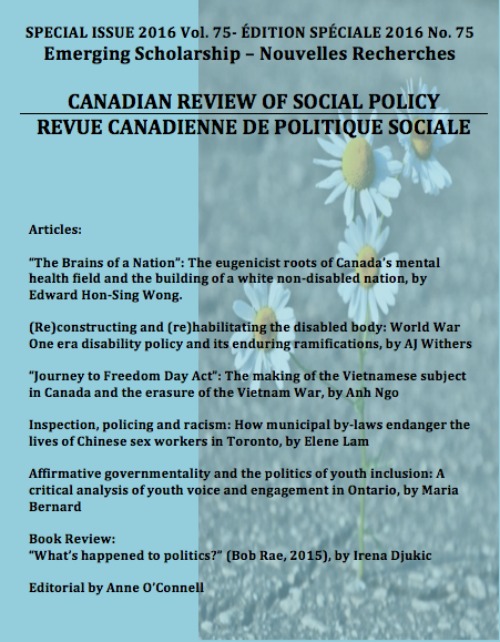(Re)constructing and (re)habilitating the disabled body: World War One era disability policy and its enduring ramifications
Keywords:
rehabilitation, pensions, disability, World War I, productivityAbstract
This article examines the emergence of federal rehabilitation and pension programs for disabled soldiers during World War One in Canada. Rehabilitation is the intervention on individuals’ behavior, minds and bodies to bring them closer to social norms and, is frequently viewed as an unproblematic good in social policy. Disability and rehabilitation were discursively constructed during this time in ways that upheld existing social values and supported capitalist production. Conceptualizations of disability were overtly linked to one’s capacity to be economically productive within federal policy and discourse. The medical model of disability was entrenched through this policy. The emergence of Canadian rehabilitation programs for injured soldiers remains significant to Canadian social policy both because it set the stage for the development of Canada’s welfare policy, and residues of the disablist principles that were foundational to the program can be found within contemporary social policy. This examination demonstrates that through these programs, the federal government first interlocked disability with economic productivity in its policy and discourse, which worked to support the establishment of the medical model of disability and reinforce oppressive ideas about gender and citizenship.
(Re)construire et (re)habiliter le corps handicapé: Les politiques reliées au handicap et la réhabilitation pendant la première Guerre Mondiale et ses conséquences de longue durée
Résumé
Cet article examine l’émergence des programmes de réhabilitation et de pension fédéraux affectant les soldats ayant un handicap revenant de la première guerre mondiale au Canada. La réhabilitation comprend les interventions sur le comportement, les esprits et les corps des individus afin de les rapprocher le plus possible des normes sociales, et elle est perçue en politique sociale comme un bien ne posant aucuns problèmes. Le handicap et la réhabilitation sont construit durant cette période par un discours qui contribue au maintient de valeurs sociales dominantes et des formes de production capitalistes. Les conceptions du handicap sont alors manifestement relies dans les politiques et le discours fédéraux aux capacités du citoyen d’être économiquement productif. Le modèle médical du handicap devient fermement ancré a travers ces politiques et discours. L’émergence de programmes de réhabilitation canadiens pour les soldats blesses demeurent significatif pour la politique sociale canadienne parce que cela crée les conditions pour le développement de la politique d’aide sociale canadienne, et parce que des résidus des principes capacitistes sur lesquels ils sont fondés existent encore dans la politique sociale contemporaine. Mon analyse démontre que a travers ces politiques le gouvernement fédéral a, en premier lieu imbriquer le handicap avec l’idée de productivité économique dans ses politiques et ses discours, mais cela a aussi servi a soutenir le modèle médical du handicap comme le seul valide, et aussi a renforcer des notions opprimantes sur le genre et la citoyenneté.
Mots Clefs : réhabilitation; pensions; handicap; première guerre mondiale; productivité
Downloads
Published
How to Cite
Issue
Section
License
1-The author guarantees that the manuscript is an original work not published elsewhere in print or electronically in whole or in part, except in abstract form, that the author has the full power to make this contribution, and that the manuscript contains no matter libelous or otherwise unlawful or which invades the right of privacy or which infringes any proprietary right.
2-The author guarantees that the manuscript has not been previously published in print or electronically and that if the manuscript contains any tables, figures or images fully reproduced or closely adapted from previously published material, the author must obtain the necessary permission from the author/publisher holding the original copyright prior to publication in CRSP. The author may be required to produce evidence of permission granted to CRSP’s editors.
3-As a condition of publication in CRSP, the author assigns all copyright to CRSP, including but not limited to the right to publish, republish, and otherwise distribute this manuscript in print, electronic, or other formats. As CRSP is a non-profit interdisciplinary scholarly journal, the author will receive no royalty or other monetary compensation for the assignment set forth in this agreement.
For the purpose of full disclosure, CRSP will not normally use the content provided by the author in a commercial venture, but for the purpose of disseminating the author’s content to as many readers as possible. For distribution, third parties engaging in commercial activities may be contracted to distribute the content globally, and such parties may make a profit out of the author’s content in their normal course of business. CRSP will not pay the author or reimburse the author in any form based on such commercial activities because the conduct of such commercial activities is outside the control of CRSP.
Any future reference to or use of this published material by the authors must acknowledge CRSP as the original place of publication.
PERMISSION REQUEST/ARCHIVING
Permission is given to author(s) receiving funding via Tri-Council Agencies, the Canadian Institutes of Health Research (CIHR), the Natural Sciences and Engineering Research Council of Canada (NSERC) and the Social Sciences and Humanities Research Council (SSHRC), to make their publications freely available in an Open Access repository within the stated deadline by the Tri-Council Agencies (12 months following publication). Archiving of publication must be a manuscript copy bearing none of the CRSP headers, footers or any other distinguishing marks. No links to the article on the CRSP website is permitted.
Permission requests from third parties to reproduce articles in part or full in academic/educational publications can be directed to the managing editor of CRSP, and will not be unreasonably denied.

